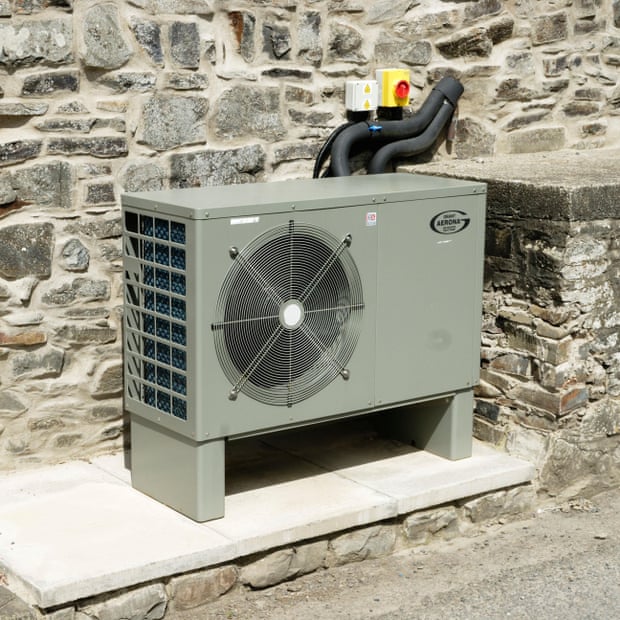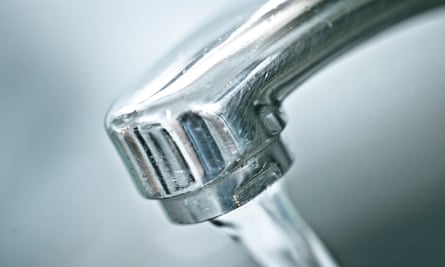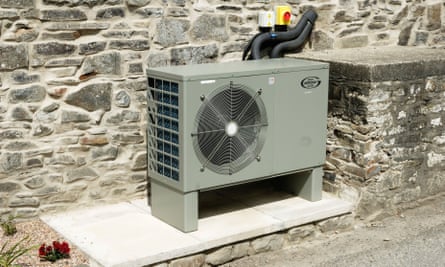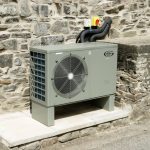Householders are being encouraged to ditch their old gas and oil-fired boilers and replace them with new clean, green heat pumps.
In the run-up to the Cop26 climate summit, the UK government has set out plans to offer grants to help households install air source heat pumps and other low-carbon heating systems over the next three years.
Central and hot water heating accounts for about 20% of the UK’s carbon emissions. An air source heat pump running on renewable electricity will heat a home much more sustainably, which is why ministers are encouraging consumers to make the switch.
‘It’s been brilliant’: air source heat pump will recoup cost for ownerRead moreQ&A
What are heat pumps and why is the UK government pushing them?
Show
In simple terms, an electric heat pump works like a reverse fridge, extracting warmth from the outside air, the ground or a nearby water source before concentrating the heat and transferring it indoors. They can usually be found outside a home, and they look like a standard air-conditioning unit.
About 85% of UK homes use gas boilers for heating, making it one of the most polluting sectors of the economy. The fossil fuels used in our homes for heating, hot water and cooking make up more than a fifth of the UK’s carbon emissions, meaning low-carbon alternatives are critical if the UK government hopes to meet its climate targets.
Jillian Ambrose
Photograph: KBImages/https://www.alamy.comWas this helpful?Thank you for your feedback.
What are they and how do they work?
In simple terms, an air source heat pump works like a reverse fridge, extracting warmth from the outside air before concentrating it and transferring it indoors to provide central heating and hot water. The pumps look like a standard air-conditioning unit and need to be situated outside the home. They will work at temperatures of minus 15c and lower, although the colder the outside temperature, the more electricity they need to consume to heat your home. Ground source heat pumps work in a similar way but collect the heat from pipes running underground. These are more efficient but are harder to retrofit to existing homes unless you are prepared to dig up your garden.
 View image in fullscreenAn air source heat pump extracts warmth from the outside air before concentrating it and transferring it indoors to provide hot water and central heating. Photograph: Jenny Dettrick/Getty Images
View image in fullscreenAn air source heat pump extracts warmth from the outside air before concentrating it and transferring it indoors to provide hot water and central heating. Photograph: Jenny Dettrick/Getty Images
What does it cost to install one?
Don’t believe some of the quoted prices that have appeared in recent days, someone with a family-size three-bed house and larger can expect to pay £8,000-£15,000 in total to install a complete air source system, while fitting out a bigger home will cost more. Alongside the pump, that price will include a new hot water tank and labour. The final bill will depend on whether your existing radiators are large enough or need to be replaced. You are also advised to upgrade your home’s insulation at the same time, which could add considerably to the final bill, depending on your home’s construction. Fitting a ground source pump will cost much more – typically upwards of £15,000.
What financial help is there?
This week the government announced it will be giving households grants of £5,000 to help them install ASHPs, with the total money allocated enough to cover 90,000 homes. There will be grants of up to £6,000 available for ground source heat pumps.
What has been less publicised is the fact that you can already apply for funding via the Renewable Heat Incentive
The grants will be available from April 2022, and details of how consumers will apply are yet to be published. The scheme will operate for three years. It is highly likely that it will be oversubscribed, meaning those who can fulfil the criteria quickest will receive the grants.
What has been less publicised is the fact that you can already apply for funding via the Renewable Heat Incentive (RHI). Buyers have to pay for the work upfront and then reclaim the RHI payments, which are paid quarterly for the first seven years of ownership. The total paid to a household under the RHI depends on the measure installed, the home energy performance and the type and age of the boiler being replaced. Those replacing an old oil-fired boiler receive the most – typically £9,000. If you replace an old gas boiler in a family-size house you can expect to receive a total £7,000. There is a calculator on the Gov website.
To gain the RHI money you must use an MCS-accredited installer and there is a somewhat torturous application process. The RHI will close to new applications on 31 March 2022.
What do air source heat pumps cost to run?
People ripping out an inefficient old oil-burning boiler should reduce their annual energy bill by going for an ASHP – but not by a huge amount. Those taking out a gas boiler are highly unlikely to see any savings and could well end up paying more each year. Octopus Energy says in a poorly insulated home it will cost as much as 40% more to run a heat pump rather than a traditional boiler. This is because the cost of electricity includes carbon taxes and subsidies to support low-carbon energy projects. Green groups have called on the government to move these levies on to gas bills instead to encourage households to turn their backs on oil and gas.
Do they work as well as a conventional boiler?
A properly installed ASHP system, which is the right size for the property, should keep house warm on the coldest winter days. They typically operate at 55C rather than the 60-80C that gas boilers will often work at, which is why they can require bigger radiators. They work particularly well with underfloor heating and are designed to keep indoor spaces at a steady temperature with gentle top-ups through the day.
What are the downsides?
 View image in fullscreenAir source heat pumps will work at temperatures of minus 15c and lower, although the colder the outside temperature, the more electricity they need to consume to heat your home. Photograph: KBImages/Alamy
View image in fullscreenAir source heat pumps will work at temperatures of minus 15c and lower, although the colder the outside temperature, the more electricity they need to consume to heat your home. Photograph: KBImages/Alamy
The biggest problem is that a great many UK homes are not suitable for an ASHP. Flat owners have struggled to get permission, and that’s assuming the installer has found a way to make a system work inside a confined space. Retrofitting a system with an existing boiler is not for the faint of heart on the basis that much of the plumbing will need to be replaced. You will also need a place to store a water tank.
There have been concerns over the reliability and longevity of some systems. Mitsubishi pumps appear to be well regarded, as do those coming out of Scandinavia, and, more recently, the Northern Irish supplier, Red. Some installed in coastal towns have suffered premature wear because of the high salt content in the air.
Is it worth it?
If you are gutting and restoring a house and putting in a whole new heating system along with a major insulation upgrade, installing an ASHP – or, even better, a ground source pump – along with underfloor heating is a no-brainer. Equally, if you are currently running an old boiler that needs replacing anyway.
Whether you will want to rip out a perfectly good, modern gas boiler will largely depend on how keen you are to move to zero carbon heating, the level of your home’s insulation and, if your insulation is poor, whether you are prepared to see your bills rise.
Is it worth waiting for an alternative technology to emerge?
Possibly. A great deal of investment is being put into community ground source heat systems, where whole roads, estates and tower blocks are plumbed into a central ground source that runs under the road. Simon Lomax, who runs Kensa Heat Pumps in Cornwall believes these offer a much better long-term solution as they are more efficient and durable, and don’t have many of the downsides of ASHPs. Hydrogen is the other great hope. Trials and schemes are testing whether the highly flammable element can be used safely.



